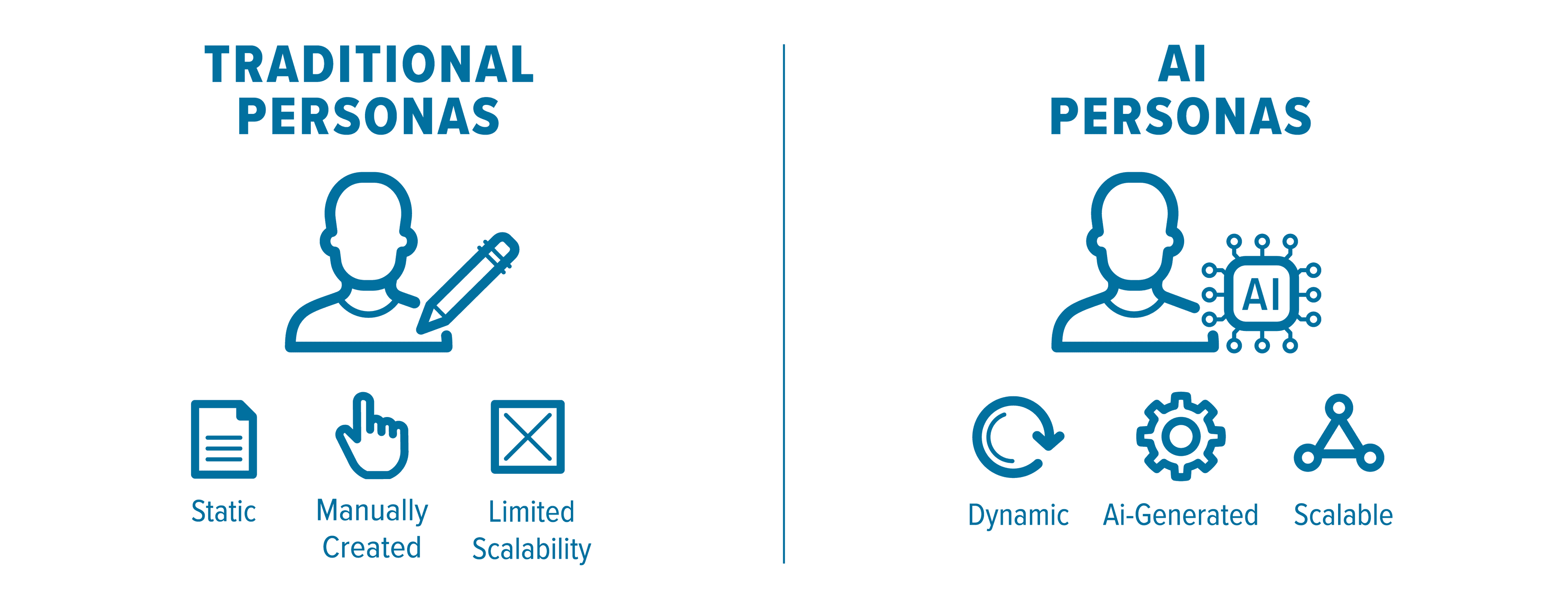- Home
- The Headlines
- Behavioral AI Innovation Brief: Exploring the Role of AI-Generated Personas in Strategic Design
Behavioral AI Innovation Brief: Exploring the Role of AI-Generated Personas in Strategic Design
AI is changing the way we think, work and create — fast. But the real opportunity isn’t speed or scale, it’s using these tools to build something that lasts. Our Behavioral AI Innovation Brief is a new series exploring how we're using artificial intelligence to help brands move beyond momentary engagement to build something deeper.
At Swanson Russell, our mission is to Make Belief.™ When audiences believe in a brand, it’s not just what they choose — it becomes a part of who they are. That kind of connection can’t be manufactured, but it can be earned with the right insights, the right strategy and the right tools. That’s where AI comes in.
In this first article, we’re focusing on advancements we are making with synthetic personas. From surfacing hidden patterns to challenging assumptions, they’re helping us bring data and empathy closer together — and opening new ways to think about strategy, storytelling and human connection. Most important, they’re helping our experts work with more intention — and build brand belief that lasts.
Synthetic Personas: Bridging Data and Empathy
Synthetic personas are giving us deeper, direct access to how audiences think. Instead of static profiles or demographic snapshots, they offer dynamic simulations of how different people might respond, decide and behave. But their value goes deeper than prediction.
At their core, our synthetic personas create a shared space for discussion — a lens that helps teams explore customer perspectives with empathy and imagination. By anchoring data inside relatable people with real stories, they turn raw insights into something actionable and human. This opens new possibilities for strategic design rooted in empathy.
Why Personas Still Matter
In marketing, product development and user experience design, personas have long served to humanize the customer journey. They give teams a narrative framework to imagine their audience’s needs, goals and behaviors. But traditional personas, while useful, are often static — limited by the assumptions of the people who create them.

AI-generated personas introduce something new: the ability to simulate behaviors across different contexts and datasets, offering a more dynamic and scalable approach to representing diverse customer experiences. By modeling potential reactions and choices, synthetic personas invite teams to consider scenarios they might otherwise overlook — and challenge their own assumptions along the way.
These new personas become a powerful new tool that helps teams think more broadly, question more deeply and design more thoughtfully.
Anchoring Data in Relatable Stories
Synthetic personas do more than predict behavior. They act as catalysts for deeper conversation and smarter ideation. They help our teams and clients see their audiences more fully — bridging the gap between raw analytics and empathetic engagement.
When teams have a persona they can talk to, data stops feeling distant or abstract. It becomes something they can work with, challenge and build upon. That process makes insights more accessible — and storytelling turns synthetic personas into a powerful tool for strategic design, sparking richer dialogue and fresh perspectives.

The Strengths (and Constraints) of Synthetic Personas
Like any tool, synthetic personas come with advantages and limitations. One of their greatest strengths is the ability to distill large, complex datasets into understandable, relatable models. They allow teams to quickly explore different audience segments, test hypothetical responses and generate insights — without requiring direct customer interactions at every step.
But they’re not perfect. Because they’re built from aggregated data and algorithms, synthetic personas can reflect biases embedded in their training sets. They may also lack the nuance, unpredictability or emotional depth of real human behavior. And just like traditional personas, they’re models — not mirrors — of reality.
While we’re addressing these challenges in our lab, we still caution our clients to view them as conversation starters, not decision-enders. They provide a valuable launch point for strategy and ideation, but they still need validation, testing and refinement through real-world input. Their value lies in opening up thinking.
Regional Differences: A Practical Example
Synthetic personas have proven particularly valuable in identifying regional influences and differences in consumer priorities. For example, when analyzing preferences for zero-turn mowers across different U.S. regions, we uncovered striking contrasts between Midwestern and Southeastern customers.
In the Midwest, personas emphasized durability, maintenance efficiency and practical features — aligning with a culture of long-term investment and hands-on ownership. In contrast, Southeastern personas prioritized aesthetics and eco-friendly technology, reflecting values tied to property appearance and environmental consciousness.

By simulating conversations and decision-making across these personas, we revealed how different segments might respond to innovations like automation, digital maintenance alerts or low-emission engines. That helped shape product development and messaging strategies that respected both functional and emotional needs unique to each region.
The Takeaway: A Tool for Human-Centered Strategy
Synthetic personas won’t replace real customer research — nor are they meant to. But they do something essential: they make data feel human, accessible and actionable. They give teams a common language to explore possibilities, weigh tradeoffs and imagine outcomes through different lenses.
By turning complex data into relatable narratives, synthetic personas help close the gap between analytics and empathy. They prompt better questions, more inclusive thinking and more intentional design.
Data is everywhere. But understanding is still rare. Tools like synthetic personas offer a new lens for understanding audience behavior. As we continue to refine how we create, validate and apply synthetic personas, we’re excited by their potential to keep pushing strategy forward — one conversation at a time.
Want to see how we can use innovation to Make Belief in your brand? See how we’re using AI-generated personas to turn data into a deeper connection — then let’s talk about what it could mean for you.


